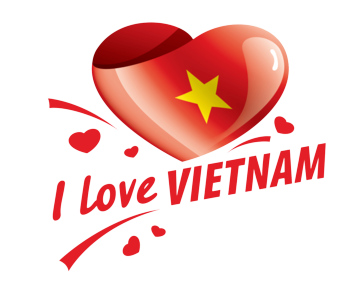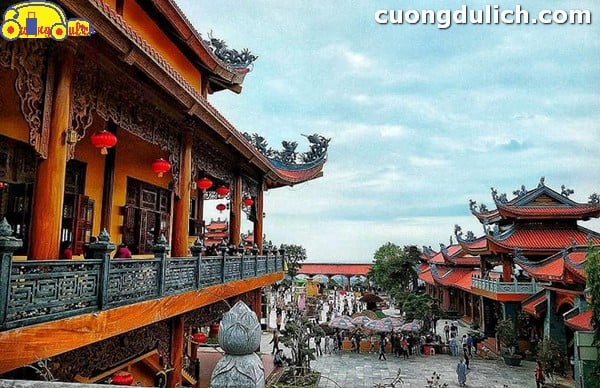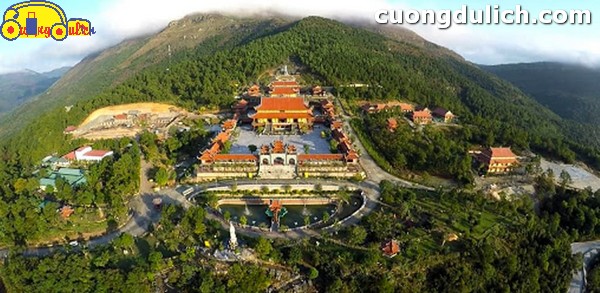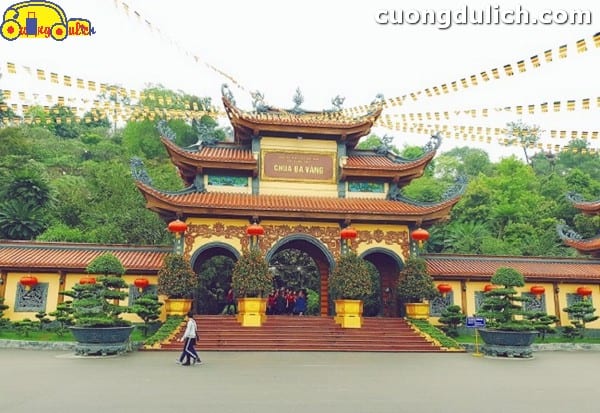After the trip to Ha Long. Now Cuong would like to share one of the most impressive tourist destinations in Ha Long – Ba Vang Pagoda. Ba Vang Pagoda is extremely attractive to visitors from all directions. Especially for those who like to visit temples, Ba Vang Pagoda is a must-visit tourist destination when going to Ha Long.
What makes Ba Vang Pagoda so attractive to visitors
In recent years, tourists and Buddhists from Hanoi have been flocking to visit Ba Vang Pagoda. The reason is that this is not only a place of spiritual worship but also because it holds records such as: the pagoda with the largest Tam Bao worship place, the pagoda owning the largest red wood bell, the mountain pagoda with the largest main hall in Indochina. That is why the number of tourists coming to Ba Vang Pagoda in Ha Long is increasing. So if you intend to visit this famous Ba Vang Pagoda, why hesitate to take with you the experiences visiting Ba Vang Pagoda that Cuong is about to share below, right?
Where is Ba Vang Pagoda
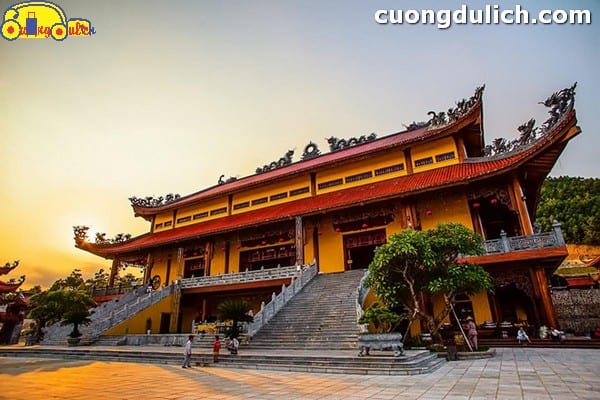
Ba Vang Pagoda is located on the back of Thanh Dang Mountain, in Quang Trung Ward, Uong Bi City, Quang Ninh Province.
Located at an altitude of 340m, with a beautiful location, with Thanh Long and Bach Ho paying homage on both sides, a river in front, a mountain behind, and pine forests on both sides, Ba Vang Pagoda has become a tourist destination that captivates many visitors when coming to Quang Ninh.
In the past, Ba Vang Pagoda was built of wood. The pagoda was built in the year of At Dau, during the reign of King Le Du Tong, which is 1706. Over time, the pagoda has been renovated and restored many times. Today, the pagoda has been invested in a magnificent and beautiful construction, leaning against the mountain.
The pagoda bears the characteristics of Northern pagodas, consisting of 3 main worship halls, 1 rear hall, including altars for Buddha, Mother, and Deity. The “Dai Hung Bao Dien” (main pagoda) has the largest scale with a 2-story architecture. Ba Vang Pagoda has the largest Tam Bao worship place and unique wooden bell recognized as the largest in Vietnam.
How to Visit Ba Vang Pagoda?
Ba Vang Pagoda is 130 km away from the center of Hanoi. To visit this tourist destination in Quang Ninh, you can use private vehicles (car, motorbike) or passenger cars to visit Ba Vang Pagoda.
– Visit Ba Vang Pagoda by motorbike or private car:
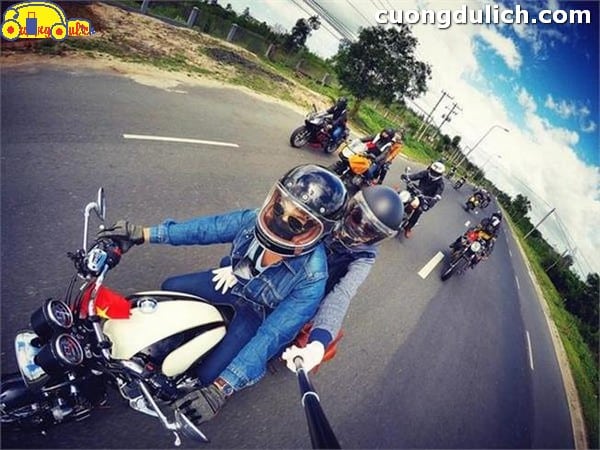
If you are an adventurous traveler who enjoys motorcycling, you can choose to travel by motorbike. With this means of transportation, you can both enjoy the scenery and control your resting time along the way as you wish. The travel time takes 3 hours. And this is the means of transportation that Cuong Travel has chosen for this trip to explore Ba Vang Pagoda this time.
Guide to go to Ba Vang Pagoda by motorbike from Hanoi:
There are two routes to go to Ba Vang Pagoda from Hanoi that you can choose:
– Go along National Highway 5: Hanoi – Hai Duong – Quang Ninh
You depart from downtown Hanoi towards Chuong Duong Bridge to cross the Red River. Then go straight to Highway 5 towards Hai Duong. It will take you about 1 hour to reach Hai Duong, which is 55km away. From this point, turn left to Sao Do town and then continue for another 25km to reach Sao Do town in Chi Linh district, Hai Duong province. From this road, follow National Highway 18 for about 20km to Dong Trieu town, then enter provincial road 326 and continue for another 30km to reach Uong Bi city.
Cuong’s advice for those who take this route is that the road is quite easy to travel, the road is quite wide but there are quite a few vehicles. You should follow traffic safety regulations to protect yourself and avoid being stopped by traffic police.
You can also refer to the second route as follows:
Go along National Highway 18: Hanoi – Bac Ninh – Hai Duong – Quang Ninh
A bit different from the first route, still starting from downtown Hanoi, but not going along Highway 5 anymore, you should follow National Highway 1A and go straight to Bac Ninh city, which is only about 30km away. Then, from Bac Ninh city overpass, turn right onto the road to Pha Lai, which is in Chi Linh district of Hai Duong province. Just continue for another 25km to reach Pha Lai. From Pha Lai, continue along National Highway 18 for about 30km to reach Dong Trieu town in Quang Ninh province. Continue on National Highway 326 for about 31km to reach Pha Lai city. It’s quite easy, isn’t it? And of course, to make your journey smooth and arrive on time as planned, don’t forget to bring a map or check Google Maps.
If you are traveling to Ha Long and want to visit Ba Vang Pagoda in a backpacking style, you can use personal means of transportation such as a motorbike to both travel and enjoy the scenery without depending on others. However, for safety, you can take a passenger bus.
Going to Ba Vang Pagoda by bus from Hanoi
Currently, there are many bus companies departing from various provinces to Quang Ninh, but the most common are the Hanoi – Quang Ninh routes.
You can catch a bus at stations such as My Dinh, Giap Bat, Luong Yen, Gia Lam… depending on which station is closest to you.
Here you can catch buses with the Hanoi – Quang Ninh route with ticket prices ranging from 90,000VND – 100,000VND/one way. After arriving at Uong Bi city, you can take a taxi (about 50,000VND) to go to Ba Vang Pagoda.
Some bus companies from Hanoi to Quang Ninh that you can choose from:
– Phuc Xuyen Bus Company:
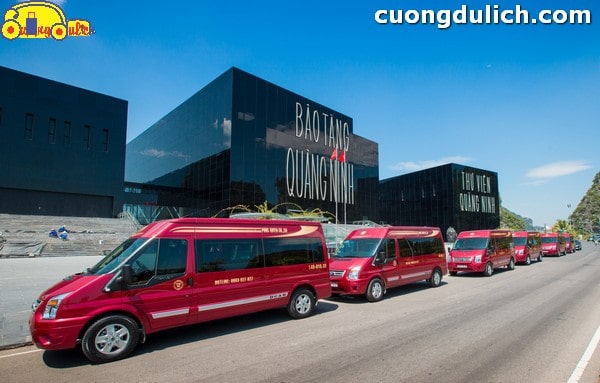
Phúc Xuyên is one of the bus companies that provides a variety of bus services with multiple routes. On average, the company operates around 40 trips per day, with each trip spaced 30 minutes apart.
The ticket prices for Phúc Xuyên buses range from 180,000 to 210,000 VND for 16-seat and limousine buses, slightly higher than other sleeper bus options. The main routes for these buses are Vân Đồn and Hạ Long, with the earliest trip departing at 5:00 from Quảng Ninh to Hanoi.
– Hoàng Phú Bus Company:
Hoàng Phú Transport Service Company Limited operates the Hanoi – Quảng Ninh – Uông Bí – Hạ Long – Hòn Gai – Cẩm Phả bus route. Hoàng Phú Bus Company specializes in passenger transportation in the northern region, particularly the Hanoi – Quảng Ninh route with a large fleet of buses. The Hoàng Phú Limousine service offers Vip Limousine Transit Dcar New 9-seater vehicles. Ticket prices range from 200k to 230k VND, and the company provides 23 trips per day from Hanoi to Quảng Ninh.
– Hùng Đức Bus Company:
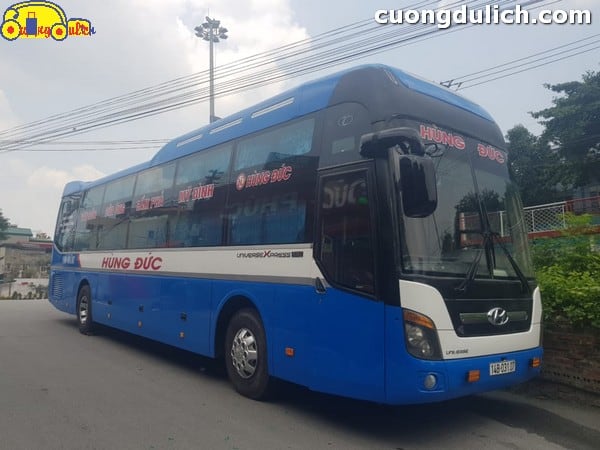
Hung Duc Bus is one of the bus companies that provide trips from Hanoi to Quang Ninh. In a day, the bus company offers about 13 trips from Hanoi to Quang Ninh, with the final stop at Quang Ninh bus station, Cai Rong station.
Ticket prices range from 170k to 220k and the buses run on the Hai Phong highway, with the latest trip departing at 20:45.
If you don’t want to be bothered with arranging your travel schedule to visit Ha Long and also include Ba Vang Pagoda, and if you lack experience in traveling to Ha Long, it might be a bit challenging, so you should consider booking a Ha Long tour to visit Ba Vang Pagoda, or book a tour specifically for visiting Ba Vang Pagoda. Cuong sees that there are many travel agencies nowadays offering all-inclusive tours to Ba Vang Pagoda, making your journey extremely attractive with detailed itineraries and experienced guides accompanying you from A to Z.
Read more: TỔNG HỢP 11 Điểm Du Lịch Hạ Long Không Thể Bỏ Qua
How long is the ideal time to visit Ba Vang Pagoda
With experience in traveling to Ha Long on a tour, visiting Ba Vang Pagoda on your own allows you to explore more tourist destinations in Quang Ninh. Cuong suggests that you should consider combining a tour to Ba Vang Pagoda with a 2-day-1-night trip to Yen Tu or a day trip to Ba Vang – Cua Ong, which will be much more wonderful. Since Ba Vang Pagoda is only 10km away from Yen Tu and 30km from Cua Ong, it is very convenient to travel between these places. The best route is to visit Ba Vang first and then move on to the other location for the most convenience.
Best Time to Visit Ba Vang Pagoda
According to the experience of visiting Ba Vang Pagoda shared by the locals with Cuong, if you want to participate in the Ba Vang Pagoda festival, the best time to visit this tourist destination is on the 8th day of the first lunar month.
Alternatively, you can also visit during the Chrysanthemum Festival at Ba Vang Pagoda, which is held on the 9th day of the 9th lunar month, known as Trung Duong Tet, the traditional Vietnamese festival of chrysanthemum flowers.
However, regardless of the season, Ba Vang Pagoda is a suitable spiritual destination for tourists.
Places to visit at Ba Vang Pagoda
Carrying the typical beauty of the Northern temples, Ba Vang Pagoda is divided into 3 main halls, 1 rear hall with altars for Buddha, Mother Goddess, and Deity. Not only that, Ba Vang Pagoda is famous for having the largest main hall in Vietnam.
Before stepping into the temple, you will be surprised by the system of statues designed in a unique and eye-catching way, all over 2 meters tall. Among these statues, the most impressive one is the giant wooden statue of Amitabha Buddha in the Northern region.
Besides the main temple, Ba Vang Pagoda in Quang Ninh also has a preaching area, monks’ quarters, library, bell tower, etc.
Another point of interest that Cuong wants to introduce to you when visiting Ba Vang Pagoda is the giant never-ending well. This well is associated with a story from ancient times that if anyone drinks the water from this well, all illnesses will disappear and the person will always be healthy. Therefore, many visitors come here hoping for a chance to drink this sacred water.
Right after the main gate of Ba Vang Pagoda in Quang Ninh is an artificial miniature mountain, which looks very natural. Therefore, contrary to the quiet atmosphere usually found in temples, at Ba Vang Pagoda, you can hear the peaceful sound of flowing water. Here, you will enjoy a peaceful and serene atmosphere, cleansing your soul from worldly dust.
In addition to the above-mentioned places, some other must-visit spots in the Ba Vang Pagoda complex are: Dai Hung Palace, Bell Tower, Drum Tower, Arhat Corridor, etc.
Within the premises of Ba Vang Pagoda, many structures are built based on historical and cultural landmarks, such as a miniature One Pillar Pagoda…
Specialties at Ba Vang Pagoda
Ba Vang Pagoda is located in Quang Ninh, so you can easily find Quang Ninh’s specialties here:
Cuong sees that almost Halong Bay tourists always buy specialties such as: dried squid, geoduck, sea cucumbers… Firstly, because they are delicious foods from Halong Bay, and secondly, they can be carried on the plane. However, you should also be careful when bringing these specialties on the plane.
1. Dried Squid
Dried squid is one of the famous and delicious specialties in Quang Ninh. The squid here is fresh and tasty, but the most special dish is probably the dried squid. The best way to enjoy dried squid is with sticky rice. The dry sticky rice is soft, fragrant with the scent of new glutinous rice, combined with the rich and sweet taste of dried squid.
However, dried squid is a fresh product, so it cannot be brought on the plane. Therefore, Halong Bay tourists traveling by plane will have to check in their luggage.

2. Yen Tu apricot wine
The apricot wine here is delicious beyond words. In addition, the wine has many health benefits such as: treating intestinal diseases, reducing anxiety and stress, providing nutrients to the nervous system, treating insomnia…
Note: You should buy apricot wine with labels, airlines allow transportation but labels must have clear information about alcohol content, ingredients, brand…
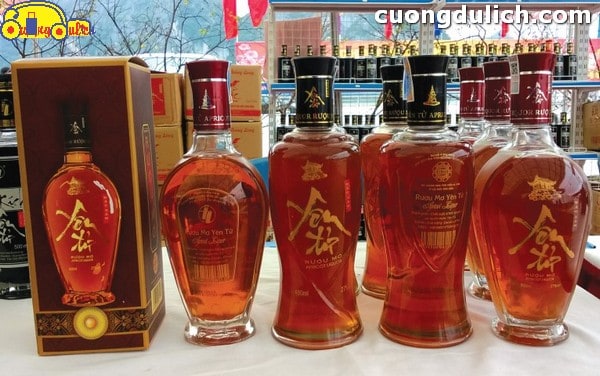
3. Con ngán
Ngán is a familiar seafood that is processed into many different dishes in Ha Long. Ngán has a shape similar to clams and oysters, but its shell is brown with a slightly rough interior, sweet taste, and a gentle aroma.
Contrary to its name “ngán” (bored), the dishes made from ngán never fail to impress tourists. The stir-fried ngán noodles in Ha Long are also very famous. When visiting Ha Long, you should try it, and you will surely praise its deliciousness. Ngán wine is also very famous and greatly loved by men.
After your trip to Ha Long, you should buy some fresh ngán to bring back as gifts for your loved ones, treating everyone to the original sweet and fragrant ngán dish from Ha Long, which is sure to be very interesting. Fresh ngán is sold for around 300,000 VND per kilogram. Make sure to ask the seller to pack it carefully to ensure the quality during transportation.
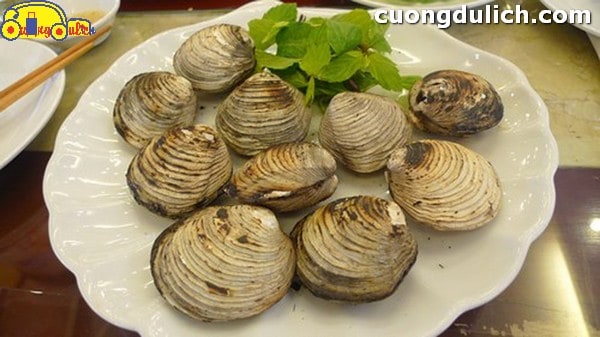
4. Sandworms
If you have already enjoyed fresh sandworms in Ha Long, then choose dried sandworms as gifts for your loved ones, friends at home after the trip. Dried sandworms can be grilled like squid, chopped and dipped in chili sauce, very delicious to eat, used as snacks, shared during gatherings, conversations are very interesting. Dried sandworms can also be roasted, when ripe they turn golden, with a fragrant and attractive aroma.
To know if it is sandworms from Quang Ninh or not, when buying you can observe with the naked eye because sandworms from Quang Ninh usually have a natural light color, short body, fat and thick. There are many types of sandworm products on the market today, but they are falsely labeled as sandworms from Quang Ninh to sell at a higher price, especially the Chinese sandworms. Chinese sandworms are usually white and when cooked they have a fishy taste and are not as fragrant as Quang Ninh sandworms. Therefore, when buying Quang Ninh sandworms, you should be cautious in choosing and buying different types of sandworms.
With fresh sandworms, you can enjoy them right at the restaurants in tourist destinations. Or if you want to buy fresh sandworms to take home, look for fresh sandworms that have been gutted and cleaned.
As for dried sandworms, they are usually bought more as gifts by tourists than fresh sandworms. Because they are easier to store and use. However, if Ha Long tourists still want to buy fresh sandworms as gifts, pay attention to careful packaging for convenient transportation.
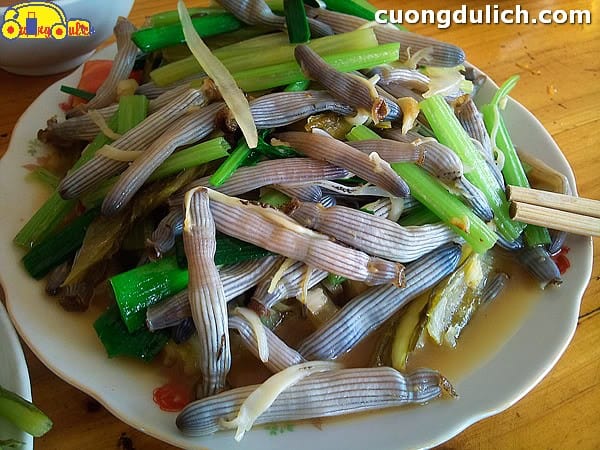
5. Bánh gật gù
Bánh Gật Gù is a specialty of the Tiên Yên region, steamed and rolled like rolled cake. The cake has a flavor similar to pho but is softer and chewier because people add cold rice while grinding the flour.
Bánh gật gù is delicious when eaten hot, but if you bring it back to the city, you may worry that the cake will dry out and not taste as good. So, it’s better to enjoy it during a few days of your Ha Long travel, buying it back to eat might be a waste of effort.

6. Tiên Yên Hill Chicken
Exploring Quang Ninh, you will hear a local saying: “Móng Cái Pig – Đầm Hà Girl – Tiên Yên Hill Chicken”. The Tiên Yên hill chicken is a breed of hill chicken that climbs steep slopes all day, searching for worms, resulting in yellow skin, fragrant meat, and sweet water. They are called hill chickens because the local breed here is raised freely, wandering on the hillsides every day to forage for worms, grasshoppers, ants, and termites. In the evening, they return to the garden, and these chickens have the habit of flying up to sleep on tree branches. It is said that because of their extensive walks and flights and the unique natural foods they consume, the Tiên Yên hill chicken meat is exceptionally sweet, firm yet tender, not tough; fatty but not greasy. People from everywhere also call this breed “bearded chicken” because the hens have long tufts of feathers under their beaks.
Sitting at a seaside restaurant enjoying Tiên Yên hill chicken is incomparable, as you get to savor the delicious flavors of the land and sea while immersing yourself in the natural beauty of the ocean. Sounds interesting, doesn’t it? If your Ha Long tour is short, you can buy this Ha Long specialty as a gift, but remember that the chicken must be cooked before being packed in your luggage, as live poultry is not allowed to be taken with you.
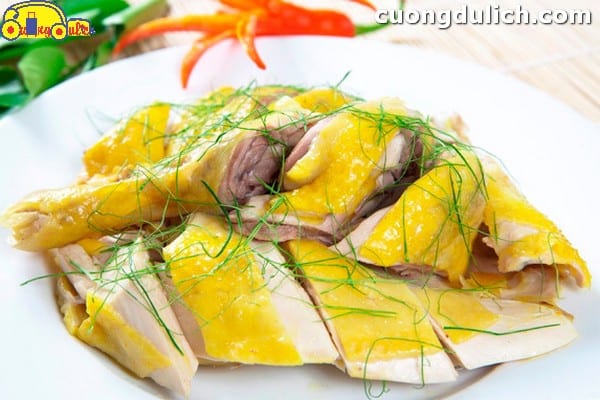
7. Nem chua, nem chạo
Nem chạo, also known as nem thính, is made by locals from shredded pig skin and thính, which is roasted rice. This specialty dish of Ha Long is often wrapped in rice paper and eaten with banana leaves, perilla leaves, Vietnamese balm, and dipped in a bowl of diluted sweet and sour fish sauce. Nem chạo has become a specialty that every tourist wants to buy as a gift.
One thing to note about this Ha Long specialty is that nem chua, nem chạo is wrapped in banana leaves and has a short shelf life, so tourists in Ha Long who buy this specialty as a gift should only buy enough to eat, so it’s fresh. If you still crave it after your trip to Ha Long, remember to ask for a business card when buying nem.
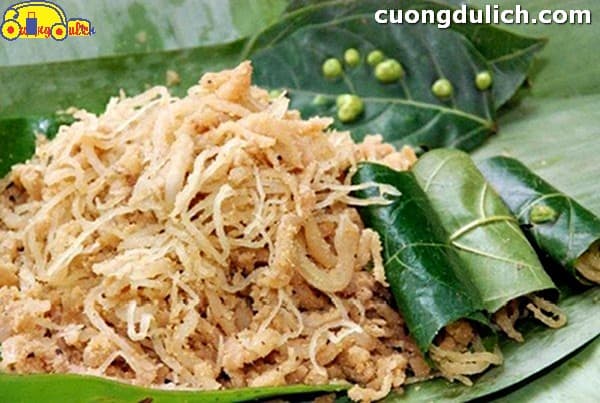
Just mentioning a few dishes makes me want to return to this tourist destination immediately to enjoy them again! When traveling to Quang Ninh, don’t forget to try the dishes I just listed; they will surely not disappoint you.
Notes when visiting Ba Vang Pagoda
1. Do not use impolite language or speak loudly.
Speak softly, calmly, and politely. Do not push or jostle while walking or standing; instead, assist the elderly and children. I have traveled to Ha Long many times and have encountered tourists arguing loudly, disrupting the order and tranquility of the pagoda. To maintain the sacred atmosphere at Ba Vang Pagoda, management should take strict measures against disruptive behavior and impolite speech, ensuring a civilized and peaceful environment.
2. Do not bring weapons, drugs, or explosives into the pagoda.
Not only at Ba Vang Pagoda but throughout Vietnam, the possession and use of weapons, explosives, and illicit materials are strictly prohibited. According to my knowledge, individuals caught transporting or storing weapons can face administrative fines ranging from 4 to 8 million VND (for small quantities without a permit or with an expired permit) and from 8 to 12 million VND (for large quantities without a permit or with an expired permit).
3. Do not enter restricted areas and the monks’ quarters. Do not litter in the pagoda grounds.
With today’s environmental protection awareness, tourists are becoming more conscious, and littering has significantly decreased. Most pagodas now have trash bins available, so be a responsible traveler and help keep the environment clean and beautiful.
4. Avoid inappropriate behavior at the pagoda.
Many Ha Long tourists, especially foreign visitors, often wear revealing clothing at Ba Vang Pagoda. This may be due to cultural differences, but tour guides should remind visitors about appropriate attire to show respect for the sacred site.
5. Offerings should be arranged solemnly. Donation money should be placed in the designated boxes, not scattered around.
Arranging offerings carefully and respectfully shows reverence. Visitors should place donations in the designated boxes or contribution desk instead of leaving money scattered around, which affects the pagoda’s aesthetics.
6. Ask for prices before buying souvenirs, especially during festivals.
There are many souvenir and food stalls around the pagoda. First-time visitors should ask for prices beforehand to avoid being overcharged, especially during peak holiday seasons.
7. Wear appropriate, modest, and comfortable clothing.
Improper attire may result in being stopped at the gate by the pagoda staff. As with any sacred site, your attire should reflect your respect. Choose simple, neat, and modest clothing, avoiding revealing outfits.
8. Wear comfortable shoes for easy movement.
Flat shoes or sneakers are recommended over high heels, as the pagoda has a large area with many stairs. Comfortable footwear ensures a pleasant experience, especially on rainy days.
9. Bring small change for convenience when making offerings.
Some pagodas offer small-change exchange services, but Ba Vang Pagoda does not. Visitors should prepare small denominations in advance.
10. Avoid buying unverified or superstitious products.
Scammers often sell counterfeit or low-quality goods during festivals. Be cautious and examine items carefully before purchasing. Avoid overly advertised products.
11. Ask locals for recommendations on reputable stores.
Locals can guide you to trustworthy stores, ensuring quality purchases while promoting their local economy.
See more: Affordable Ha Long Travel: Top 10 Beautiful Tourist Spots
Ba Vang Pagoda Entrance Fee
Visiting Ba Vang Pagoda is free. However, visitors may contribute donations to help maintain the site.
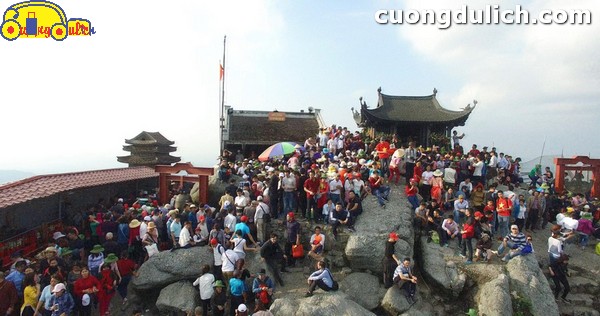
Currently, there are many travel companies selling tours to visit Chua Ba Vang – Yen Tu at a reasonable price. You can visit travel websites to have the most convenient and enjoyable trip.
If you choose to travel independently, from Chua Ba Vang, you can choose a motorbike or taxi to visit the Yen Tu tourist destination, which takes about 30 minutes to travel.
Unlike Chua Ba Vang, to visit Yen Tu, you will need to take a cable car.
Below are the current cable car tickets for Yen Tu that Cuong has researched and wants to introduce to you:
The Yen Tu tourist area consists of 5 areas: Dong Yen Tu historical site and scenic spot (Uong Bi City, Quang Ninh), Tran Dynasty historical site (Dong Trieu, Quang Ninh), West Yen Tu historical site and scenic spot, Con Son historical site – Kiep Bac – Thanh Mai.
Popular tour itinerary: Thien Vien – Giai Oan Bridge – Giai Oan Pagoda – Hoa Yen Pagoda – Mot Mai Pagoda – Bao Sai Pagoda – An Ky Sinh and Phat Hoang statue – Dong Pagoda – An Ky Sinh – Bao Sai Pagoda (take the cable car down) – Hoa Yen Pagoda – Giai Oan Pagoda – descend to the parking lot.
Yen Tu Cable Car Ticket Prices
As Yen Tu is only 10 km away from Chua Ba Vang, if you want to enrich your travel journey, visit Yen Tu.
If you take the cable car, it is best to buy a round-trip ticket for both lines, go to An Ky Sinh statue, then descend, climb about 200m more to reach the peak of Yen Tu.
Many tourists choose to hike up to Dong Pagoda and then buy a one-way cable car ticket down. Cuong’s advice is not to buy a cable car ticket halfway as it will be very expensive.
Specifically:
– Line 1 (Giai Oan – Hoa Yen): One way 120,000VND – Round trip 200,000VND
– Line 2 (Mot Mai – An Ky Sinh): One way 120,000VND – Round trip 200,000VND
– Both lines: One way 120,000VND – Round trip: 280,000 VND
Free tickets for children under 6 years old (height under 1m2)
Elderly people over 70 years old: Provide ID card
Monks, veterans: Present your card
Cable car service hours:
– Festival season (from January to March lunar calendar): from 5am to 8pm daily.
– Outside the festival season (from April to December lunar calendar): From 7am to 6pm daily.
2.Den Cua Ong
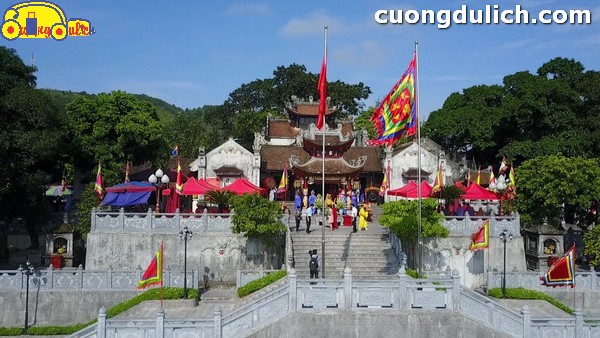
Also a tourist destination located 30 km away from Ba Vang Pagoda that you can combine to visit on your Ba Vang Pagoda tour.
Cua Ong Temple is situated on a low mountain overlooking Bai Tu Long Bay, with a beautiful landscape, in Cua Ong ward, Cam Pha town, Quang Ninh province, more than 40km northeast of Halong City. This is the only temple that worships the full Tran Quoc Tuan family and his close deities that remain to this day with 34 large and small statues intricately carved with high artistic value. Cua Ong Temple has been recognized as a scenic relic by the Ministry of Culture and Information. Cua Ong Temple was built in the early 19th century and consists of 3 main areas: Lower Temple, Middle Temple, and Upper Temple. The main temple initially worshipped Hoang Can, a local hero, then Tran Quoc Tang, the third son of Tran Quoc Tuan, who had the merit of defending the Cua Suot area. This is the only temple that worships the full Tran Quoc Tuan family and his close deities that remain to this day with 34 large and small statues intricately carved with high artistic value. These include statues of Tran Quoc Tuan, Holy Mother (his wife), 2 princesses (his daughters), Tran Quoc Tang, Tran Anh Tong, Tran Khanh Du, Yet Kieu, Da Tuong, Pham Ngu Lao, Le Phu Tran, Do Khac Trung, and some other couplets and altars.
Cua Ong Temple is located on a low mountain overlooking the sea, with a very spectacular landscape that can capture the entire beautiful scenery of the coal region of Cam Pha and Bai Tu Long Bay within sight. For a long time, Cua Ong Temple has been famous and sacred not only to the people of Quang Ninh but also to people from other provinces who come to offer incense and attend festivals. The Cua Ong Temple festival takes place from the 2nd day of the 1st lunar month and lasts until the end of spring.
3. Cai Bau Pagoda
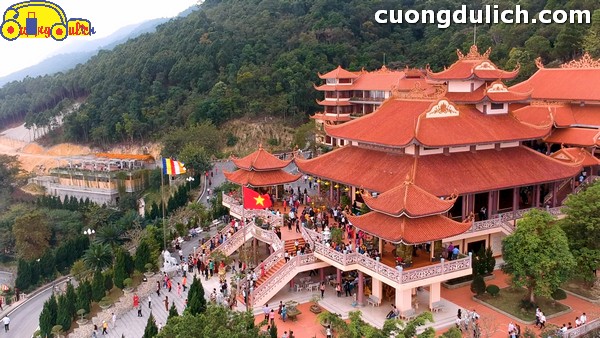
About 50km from Ba Vang Pagoda, Cai Bau Pagoda is also a famous tourist destination in Quang Ninh that you should visit on your Quang Ninh tour.
Cai Bau Pagoda – Truc Lam Giac Monastery is a spiritual and cultural work with beautiful architecture and landscape located on the banks of Bai Tu Long Bay, which is closely associated with the heroic achievements of the valiant heroes who defended the northeastern frontier. This is also where the victories in the fight against the Mongol invaders of the Tran dynasty are recorded. Over time and historical ups and downs, the pagoda was heavily damaged. In the 1990s, the pagoda was restored but still simple and lacking planning.
Above are the experiences of traveling to Ha Long, visiting Ba Vang Pagoda that Cuong wants to share with those of you who are planning to visit the famous tourist destination Ba Vang Pagoda in Quang Ninh. Hopefully, the travel experiences that Cuong Travel shares will provide you with the most useful information to have the most complete visit to Ba Vang Pagoda.
